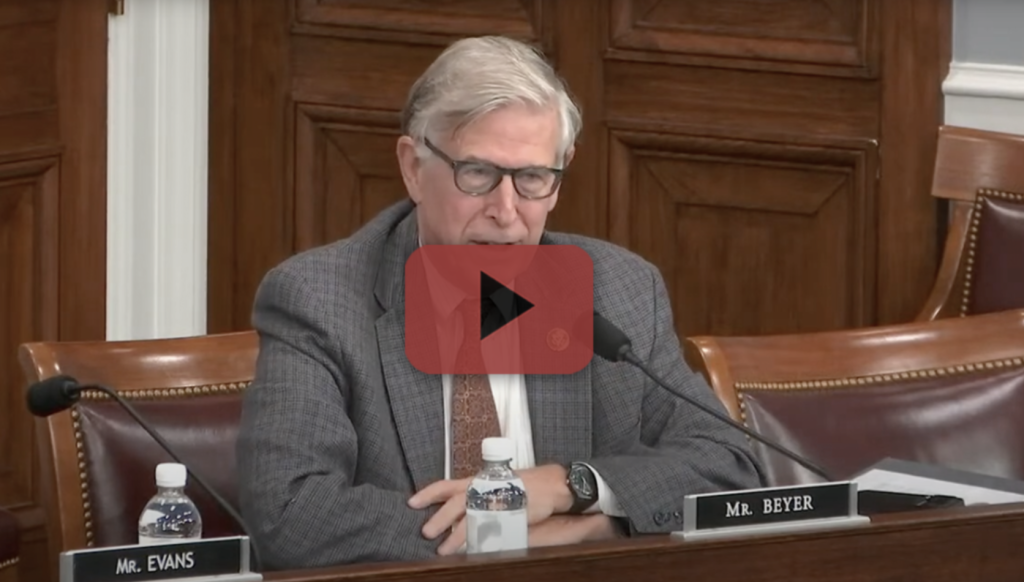WASHINGTON – With more than 1 million Americans stuck in the Social Security disability claims backlog, members of the House Committee on Ways and Means urged the Social Security Administration (SSA) to significantly speed up processing times during a hearing. Applicants are waiting 220 days for an initial decision and another 213 for an initial appeal. The SSA’s minimum standard is to wait no longer than 58 days, a standard it has not met in over 40 years. Worse yet, the SSA is exacerbating the problem by spending more than $100 million on outreach efforts to increase initial disability claims instead of prioritizing clearing the existing backlog.
Witnesses shared examples of how the SSA fails to use tools it already has, including the agency’s continued use of occupational data last updated in 1991, despite spending $300 million to upgrade that very same information. Witnesses also shared how reversing previously allowed efficiencies and a continued reliance on manual processes are leading to long wait times for beneficiaries and how the SSA has been sitting on systems and regulatory upgrades after more than a decade of review.
“20 Years Is Long Enough”: SSA Dragging Its Feet Implementing Reforms That Would Speed Up Claim Processing
In order to determine if a disability claimant can work, SSA relies on job data that has not been substantively updated since 1977 and does not reflect changes in the workforce. SSA has spent $300 million to develop a more accurate database that reflects work the modern economy. Yet, this new data is not being used, even though the data is ready to go and SSA has confirmed that it’s more useful and accurate. Social Security Subcommittee Chairman Drew Ferguson (GA-03) held the agency’s feet to the fire on why it has taken years to implement the new directory.
Rep. Ferguson: “Help us solve this mystery…We heard from a group last week talking about…trying to speed up claims on the beneficiary side, we’ve got programs that were authorized eight years ago that still haven’t been implemented. Same thing. You’ve got great technology. Explain to us why you all can’t get this done.”
Linda Kerr-Davis, Social Security Acting Assistant Deputy Commissioner: “I understand that this is a complex multi-year plan that we need to move through.”
Ferguson: “20 years isn’t long enough?”
Kerr-Davis: “That is long enough. Yes. We have been making progress. And we have met our goals for reviewing and updating the medical criteria, and also the occupational data.”
Ferguson: “I promise I’m not trying to be combative. I’m just trying to understand. So you’ve met your goals, yet we’re 20 years from implementation.”
Long Wait Times Discourage Americans With Disabilities From Claiming Benefits
On average, disability claimants wait an average of seven months for a decision about their claim, and another seven, if their claim is denied and they choose to appeal. Part of the issue is the outdated jobs directory that forces employees to spend days determining how a directory from 1977 applies to today’s workforce. Earlier in the hearing, David Camp, an attorney for disability claimants, shared an emotional story of one of his clients dying of the disease preventing him from working while the SSA wasted hundreds of days on his claim. Rep. Ron Estes (KS-04) asked him to elaborate on how long wait times discourage Americans from getting the benefits they need.

Rep. Estes: “Mr. Camp, your story really is heart-rending, in terms of the issues that the individual that you referenced went through. How does something like the outdated DOT [Directory of Occupational Titles] affect applicants in the process they go through to get their claims?”
David Camp, the interim CEO for the National Organization of Social Security Claims Representatives (NOSSCR): “To wait hundreds of days only to be told that you’re denied because you should go do a job that even the claimant knows obviously does not exist is discouraging. Deeply bothersome. The claimants often stop the process. They leave the claims process.”
Social Security Must Update Its Technology: “Move Past Fax Machines”
The SSA’s technology to process claims is woefully outdated. Certain digital efficiencies once allowed have been reversed. Earlier this year, SSA prohibited Americans from even using fax machines to send paperwork, resulting in applicants having to mail paperwork, further slowing down the process. Though reversing the ban on faxes would be helpful, Rep. Blake Moore (UT-01) urged SSA to bring its technology into the 21st century and trade outdated tools like the fax machine for digital solutions.

Rep. Moore: “Mr. Camp, do you have anything to add?”
David Camp, of NOSSCR: “They already have the fax machines in every office. They already turn them on in the morning. Count it. Let us actually fax something and let us save those weeks. Easy.”
Moore: “I would argue that we should be moving past fax machines too.”
Biden Administration Stopped Turnkey Policies That Would Have Sped Up Processing Times for Disability Claims
Several Ways and Means Democrats argued that the SSA would benefit more from better policy than a new influx of taxpayer dollars. In one instance, one witness shared with Rep. Don Beyer (VA-08) that a policy to simplify and update rules for eligibility of disability benefits already existed and was ready to be implemented at the end of the Trump Administration. However, for “inexplicable” reasons, the Biden Administration has chosen to put that policy on ice.
Rep. Beyer: “Thank you, Dr. Warshawsky. Let me quote you, ‘The currently needlessly complex and outdated rules that both claimants and the agency use to determine eligibility for disability benefits have to be simplified, modernized, and automated.’ Is there anyone charged with doing this? Who owns that charge?”
Dr. Mark Warshawsky, former Social Security Deputy Commissioner: “When I was at Social Security, I was in charge, and the regulation was written. In fact, it was ready to go literally days before a change of administration. It’s there, and it was an agency-wide, in fact, even a government-wide effort. It involves people from the Office of Management and Budget, and they have extensively involved the entire agency, people in operations, people in the actuaries office, people in the hearings office, the budget office. It was a total agency effort. My very rough estimate is that it cost $100 million in terms of people-time to do that, in addition to the expenditure of $300 million for the data. And it stopped. It’s sort of inexplicable…It would definitely speed things up, because it would be automated. And it would be relying on current data. So that would provide much more accuracy at the initial level in the claims. I think it would be a vast improvement.”
LISTEN: Disability Beneficiary – I Was Denied Disability Benefits The Same Time I Experienced Debilitating Pain From My Illness
Social Security’s disability claims backlog has real impact on applicants counting on these benefit payments to take care of their families when they suffer a disabling condition that prevents them from working.
In a moving story, a disability beneficiary narrated her account of the application process. She detailed how her initial application was denied after a year of waiting, even though her claim should have been allowed in a matter of weeks due to the severity of her illness. While her claim was eventually approved and she received back pay, the SSA still hasn’t sent her first monthly benefit check, and the tortuous process left her with bills she is still trying to figure out how to pay today. In her statement, she calls on the SSA to improve its adjudication processes because sadly, her story is not unique.
Disability Beneficiary: “It was a semi-typical day. I was leaning on the countertop in our hall bathroom waiting for my 2-year-old to finish going to the toilet. My husband was in the bedroom sleeping off the previous night’s third shift from his job but had his phone on full blast in case I needed help. Suddenly the muscles around my ribs cramped and I could barely get air in. I pulled out my cell phone and called my husband and said one quiet word, “Help”. As I went to my knees, I thought to myself, “I’m going to die on the bathroom floor in front of my 2-year-old.” At that moment, the Social Security Administration had denied my claim for disability, stating that I was capable of work. If my husband hadn’t brought my rescue medication, I would have died that day.
“‘Stiff Person Syndrome is an exceptionally rare (literally one in a million) permanent and progressive autoimmune neurological condition that the primary symptom is severe muscle cramps and spasticity. The spasms in me have torn multiple ligaments, broken multiple ribs, given me multiple attacks where I cannot breathe, and have left me screaming in agony more times than I can attempt to count. It also affects my central nervous system causing things like seizures and vision problems.
“I do my best to complete something productive each day and be a member of my small family, but most of my time is spent asleep, either because of sheer exhaustion or the many medications I have to take each day. The two primary causes of death from Stiff Person Syndrome are spontaneous apneic episodes, and suicide. Let me repeat that. I am most likely to die from suffocation or suicide.
“It took me weeks to complete the Social Security application, both because of the breadth of information required as well as system errors that would cause entire pages to empty of data. I received many unclear letters in the mail. Each time this occurred, I had to call up to confirm that my application hadn’t been lost and that I was still in the queue to be deemed disabled.
“Stiff Person Syndrome is on the compassionate allowance list. These are supposed to be the cases where the illness is so severe that there doesn’t need to be a wide assessment of validity of the disability. However, my case was not treated this way. My case was denied.
“We were living on savings and a very small private disability insurance payment, each month we were calculating how much longer we had to live before the money ran out. I emptied my 401k, we had to pay bills late. We had to delay some treatments for my autistic son.
“Once my case was finally reassessed, my disability claim was approved and we received back pay, but my lawyer wasn’t paid and now I have to figure out how to address that issue. I am still awaiting my first monthly payment, but it has taken fifteen months.



